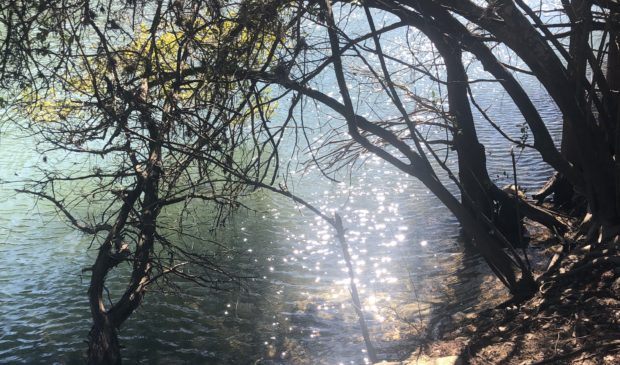City begins blue-green algae mitigation at Red Bud Isle
Thursday, June 24, 2021 by
Sean Saldaña Since 2019, dog-lovers in Austin have had to worry about cyanobacteria, more commonly known as blue-green algae, when stories came out of several dogs dying after swimming in Lady Bird Lake during the algae bloom.
A particular area of concern has been Red Bud Isle, a popular destination for outdoor enthusiasts. Since the initial incidents, cases have continued to occasionally pop up, and in February, reports of dogs getting sick and in some cases dying after swimming in Lake Travis sparked more cause for concern. In April, the blue-green algae was confirmed to have been found in Lake Austin and Lady Bird Lake.
On Monday, the city embarked on a nine-week process aimed at addressing the ongoing algae concerns at Red Bud Isle. The city is implementing two mitigation methods; the first involves applying a material called Phoslock to around 20 acres of the water around Red Bud Isle.
Phoslock reduces the amount of nutrients cyanobacteria uses to produce harmful toxins by laying a fine clay-like layer of lanthanum-modified bentonite around the lake. The clay will have no impact on wildlife in the area or recreational use of Lady Bird Lake.
In a memo sent to Mayor Steve Adler and City Council, Jorge Morales, director of the Watershed Protection Department, noted that “over 80 peer-reviewed publications exist on Phoslock that specifically address its efficacy, longevity, and potential impacts.”
A much smaller treatment the city is trying is the installation of 50 biochar socks around just an acre of the lake. Biochar socks are tools that filter out finer materials and have the downstream effects of curbing algae growth. According to Brent Bellinger with Watershed, these socks are “essentially just activated charcoal – same thing you might have in a pool filter or in your Brita filter.”
The city is installing the socks in a smaller area of the lake and monitoring whether they will improve the algae issue.
Bellinger clarified to the Animal Advisory Commission last week that the steps the city is taking are a pilot project, “not a smoking gun cure-all.”
For the time being, the city is still recommending a number of safety measures like avoiding areas of stagnant water with algae, not allowing dogs to come into contact with or consume algae, and rinsing off dogs after contact with lake water.
In an interview with the Monitor, Bellinger went on to say that “these mitigation options are only as good as the rest of the watershed management.”
Bellinger explained that solving the larger environmental issues is a community effort that requires “broader buy-in in nutrient management practices, better land management, being conscious of how nutrient-rich the waters are coming into the Colorado River. For this type of program, the results will unfortunately be short-lived because we’ll constantly be battling against fresh inputs.”
He noted that the city is undertaking a public education campaign about stormwater management and runoff, the use of harmful chemical fertilizers and septic systems. For further updates, citizens can check the city’s website. The city will also start updating its algae monitoring dashboard soon.
The Austin Monitor’s work is made possible by donations from the community. Though our reporting covers donors from time to time, we are careful to keep business and editorial efforts separate while maintaining transparency. A complete list of donors is available here, and our code of ethics is explained here.
You're a community leader
And we’re honored you look to us for serious, in-depth news. You know a strong community needs local and dedicated watchdog reporting. We’re here for you and that won’t change. Now will you take the powerful next step and support our nonprofit news organization?





